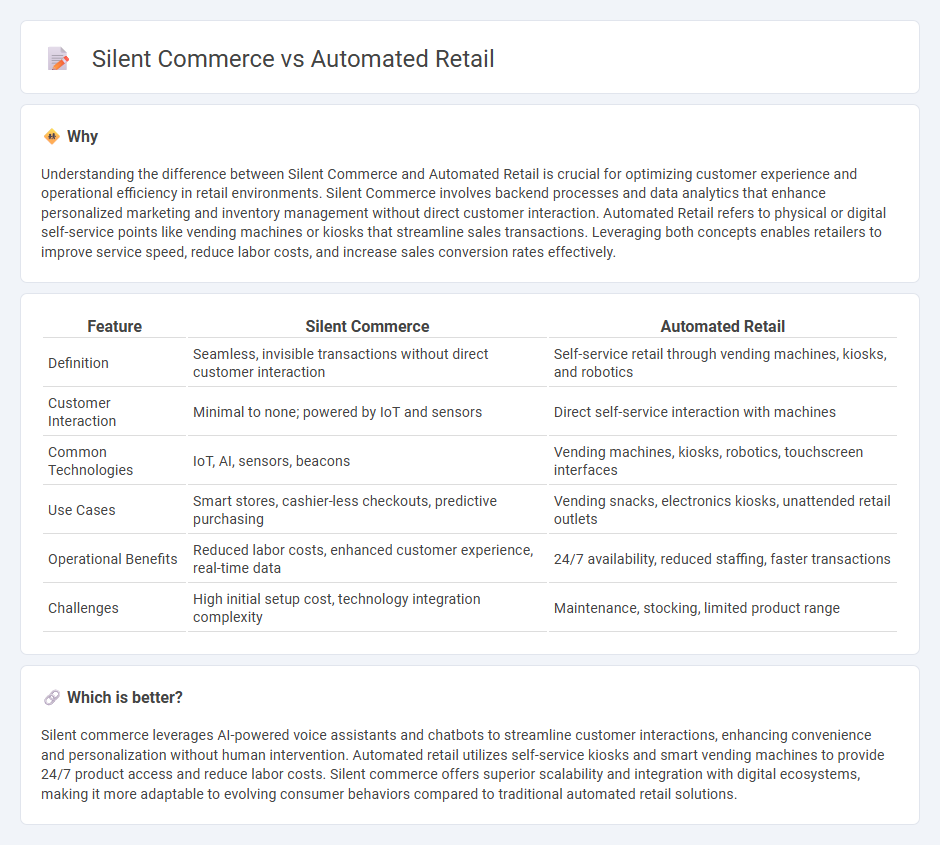
Silent commerce leverages AI-driven personalization and data analytics to create frictionless shopping experiences without direct human interaction. Automated retail employs robotics and self-service kiosks for efficient, cashless transactions in physical locations, reducing labor costs and increasing operational efficiency. Discover how silent commerce and automated retail are transforming the future of shopping.
Why it is important
Understanding the difference between Silent Commerce and Automated Retail is crucial for optimizing customer experience and operational efficiency in retail environments. Silent Commerce involves backend processes and data analytics that enhance personalized marketing and inventory management without direct customer interaction. Automated Retail refers to physical or digital self-service points like vending machines or kiosks that streamline sales transactions. Leveraging both concepts enables retailers to improve service speed, reduce labor costs, and increase sales conversion rates effectively.
Comparison Table
| Feature | Silent Commerce | Automated Retail |
|---|---|---|
| Definition | Seamless, invisible transactions without direct customer interaction | Self-service retail through vending machines, kiosks, and robotics |
| Customer Interaction | Minimal to none; powered by IoT and sensors | Direct self-service interaction with machines |
| Common Technologies | IoT, AI, sensors, beacons | Vending machines, kiosks, robotics, touchscreen interfaces |
| Use Cases | Smart stores, cashier-less checkouts, predictive purchasing | Vending snacks, electronics kiosks, unattended retail outlets |
| Operational Benefits | Reduced labor costs, enhanced customer experience, real-time data | 24/7 availability, reduced staffing, faster transactions |
| Challenges | High initial setup cost, technology integration complexity | Maintenance, stocking, limited product range |
Which is better?
Silent commerce leverages AI-powered voice assistants and chatbots to streamline customer interactions, enhancing convenience and personalization without human intervention. Automated retail utilizes self-service kiosks and smart vending machines to provide 24/7 product access and reduce labor costs. Silent commerce offers superior scalability and integration with digital ecosystems, making it more adaptable to evolving consumer behaviors compared to traditional automated retail solutions.
Connection
Silent commerce integrates automated retail technologies by enabling seamless, contactless transactions through sensors and AI-driven interfaces. Automated retail leverages smart vending machines and robotic kiosks that operate independently, minimizing human interaction and enhancing consumer convenience. Both innovations drive efficiency and elevate the customer experience by streamlining purchasing processes in retail environments.
Key Terms
Automated retail:
Automated retail leverages advanced vending machines and kiosks to provide seamless, self-service shopping experiences, enhancing convenience and reducing labor costs. This technology integrates AI and IoT to personalize customer interactions and optimize inventory management in real-time. Explore how automated retail is transforming the future of consumer convenience and operational efficiency.
Vending machines
Automated retail leverages advanced vending machines equipped with AI and IoT technologies to offer seamless, self-service shopping experiences that reduce operational costs and enhance customer convenience. Silent commerce, characterized by invisible or frictionless transactions often integrated into smart environments, complements vending machines by enabling contactless payments and personalized product recommendations. Explore how innovations in vending machine technology are reshaping automated retail and silent commerce.
Self-checkout
Automated retail streamlines in-store experiences by utilizing kiosks and vending machines that enable customers to complete purchases without staff assistance, while silent commerce emphasizes seamless transactions primarily through mobile apps and contactless payment systems integrated into physical environments. Self-checkout technology serves as a bridge between these concepts by offering fast, user-driven payment processes that reduce queues and operational costs in retail settings. Explore how self-checkout solutions are transforming consumer interactions and shaping the future of automated and silent commerce.
Source and External Links
Automated Retail Technology: Benefits & Examples (2025) - This article discusses how automated retail technology, including AI and IoT, enhances customer experiences and drives retail growth.
Automated Retail: Revolutionizing the Future of Shopping - This blog highlights innovations like smart shopping carts and AI-driven systems that are transforming retail operations and customer experiences.
Automated retail - Wikipedia defines automated retail as self-service kiosks that operate as fully automatic stores, using software to offer products via touchscreens and robotic dispensers.
 dowidth.com
dowidth.com